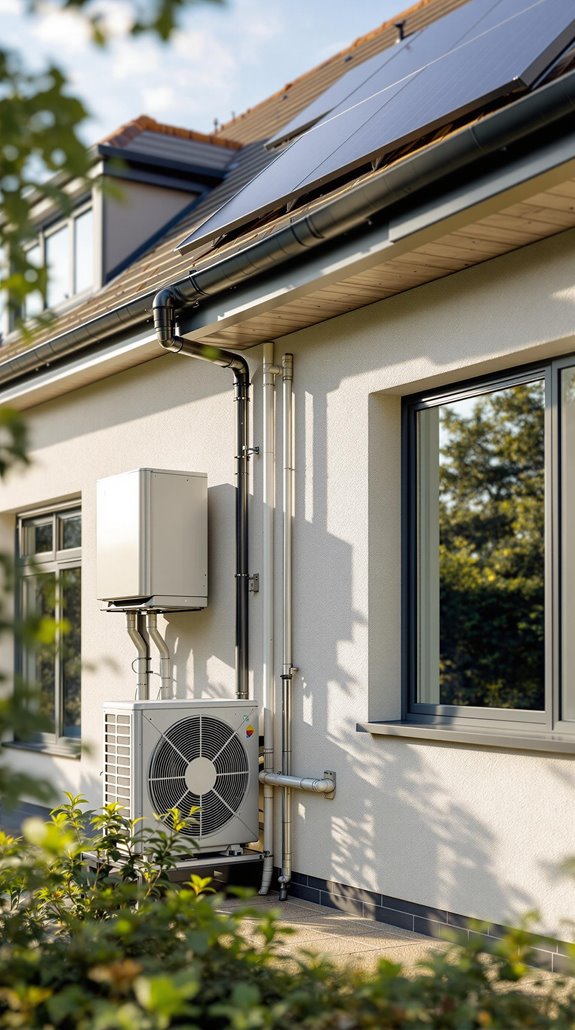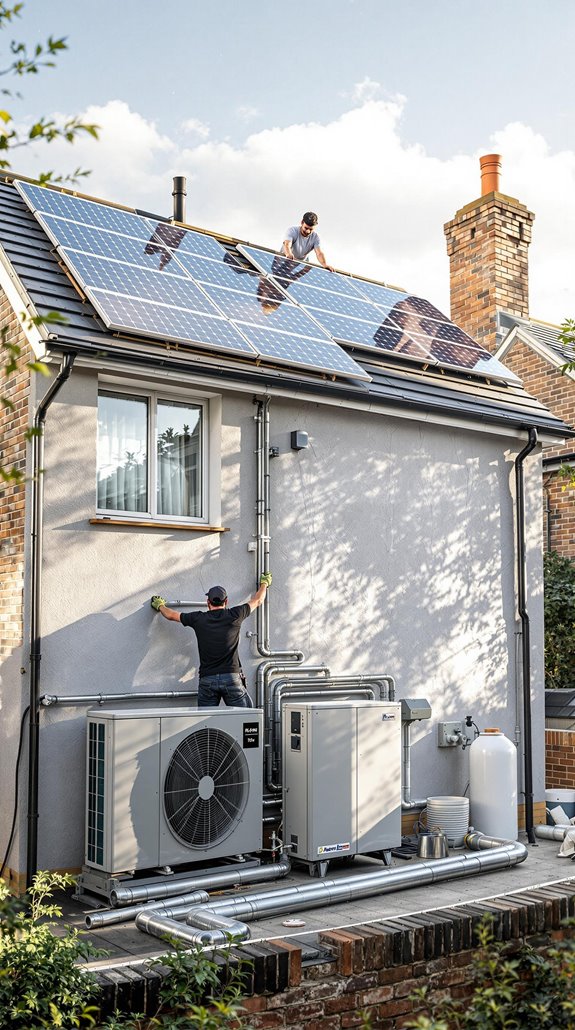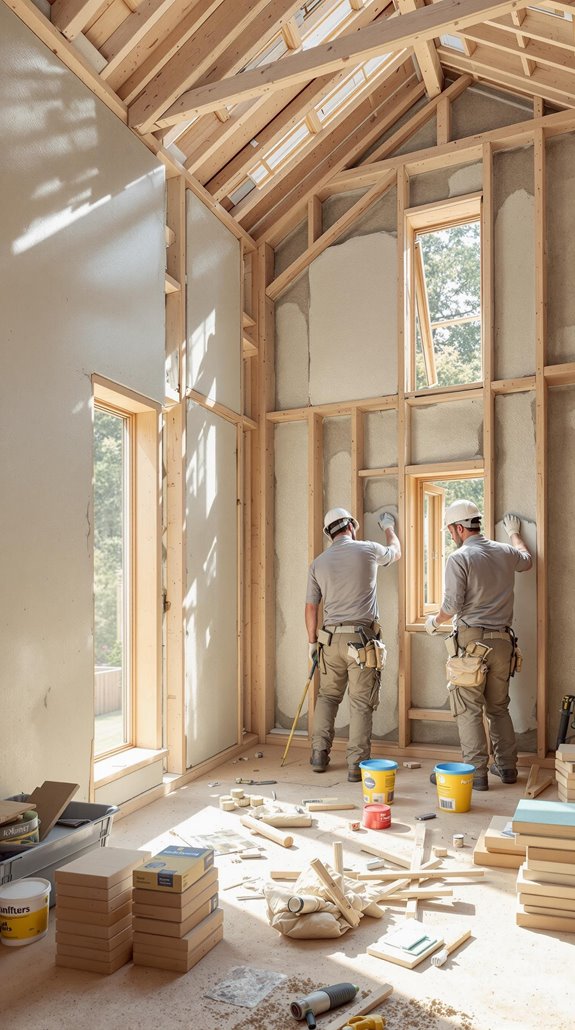I’ve guided hundreds of UK homeowners through net zero retrofits, and I’ll tell you what most builders won’t: achieving true carbon neutrality requires a systematic approach that goes far beyond swapping your boiler. You’ll need to tackle operational emissions through heating upgrades and insulation, address embodied carbon in your material choices, and integrate renewable generation—all while maneuvering through evolving UK building standards. The sequence of these interventions determines whether you’ll succeed or waste thousands on ineffective measures.
Key Takeaways
- Replace gas boilers with electric heat pumps to reduce household emissions by over 1 tonne of CO₂ annually with 300-400% efficiency.
- Install solar panels on minimum 20 square meters of roof space to generate renewable energy and sell excess back to grid.
- Add comprehensive insulation including 270mm loft depth, cavity wall injection, and upgrade to double/triple glazing for thermal efficiency.
- Use low-carbon materials like sustainably sourced timber, recycled content insulation, and reclaimed bricks to minimize embodied carbon.
- Follow the UK Net Zero Carbon Building Standard requiring fossil fuel-free operation and 60-75 kWh/m²/year onsite renewable generation.
Understanding UK Net Zero Requirements for Residential Buildings

As the UK government implements its legally binding net zero commitment by 2050, residential buildings face unprecedented regulatory changes that’ll fundamentally reshape how we design, build, and retrofit homes. The built environment accounts for 30% of UK’s total greenhouse gas emissions, making your home a critical piece of the climate puzzle.
I’ll guide you through the Future Homes Standard 2025, which mandates 75-80% CO₂ emission reductions compared to 2013 regulations. You’ll need to understand both operational carbon (energy use) and embodied carbon (materials, construction processes). The Net Zero Carbon Buildings Standard requires fossil fuel-free operation with specific onsite renewable targets: 60-75 kWh/m² for houses. This isn’t just regulation—it’s your pathway to creating a genuinely sustainable home.
Implementing a Whole Life Cycle Assessment helps you quantify environmental impacts throughout your building’s entire lifecycle, from construction materials to daily energy consumption. This assessment approach aligns with global standards and enables you to identify carbon hotspots while making informed decisions about materials and energy systems from the earliest design stages.
Assessing Your Home’s Current Carbon Footprint and Energy Performance
Before you can transform your home into a net-zero powerhouse, you’ll need to establish a precise baseline of your current carbon footprint and energy performance. I’ll guide you through collecting thorough household data using structured questionnaires covering your housing characteristics, consumption behaviors, and utility usage patterns.
Start by gathering twelve months of electricity, gas, and water bills—this primary data guarantees accuracy. Document your transportation habits including commuting distances, vehicle types, and fuel consumption. Track food consumption patterns and waste disposal methods.
Apply IPCC emission coefficients and UK-specific Defra conversion factors to calculate your total footprint in tCO₂e. Compare results against the UK average of 740 Mt CO₂e to identify high-emission areas. Understanding that economic activity influences emission patterns will help you recognize how your household’s consumption choices contribute to your overall carbon footprint. This baseline becomes your roadmap for targeted retrofitting interventions.
Upgrading to Low-Carbon Heating Systems and Heat Pumps

Once you’ve established your baseline carbon footprint, upgrading your heating system represents the single most impactful retrofit intervention you can undertake. With 85% of UK homes relying on natural gas heating, shifting to a heat pump directly addresses the 18% of national emissions from domestic heating.
I’ll be frank: heat pumps require significant upfront investment, typically £10,000+, while most homeowners budget only £5,000 for energy upgrades. However, the Clean Heat Market Mechanism now mandates proportional heat pump sales alongside boilers, creating better availability and pricing. Additionally, heat pumps often lead to lower operating costs due to their superior efficiency compared to traditional heating systems.
Your success depends on finding certified installers—a genuine challenge given current workforce shortages. I recommend securing quotes from multiple TrustMark-certified professionals and exploring financing options beyond savings, as only 16% currently consider loans despite their necessity for meaningful heating system alteration. Current Energy Performance Certificates unfortunately favor gas boiler installations over heat pumps, though reforms are being called for to better support decarbonisation efforts.
Installing Comprehensive Insulation and Thermal Efficiency Measures
While heat pumps tackle your heating emissions, extensive insulation forms the essential foundation that makes any low-carbon heating system viable. I’ll guide you through the critical measures that transform your home’s thermal performance.
Start with a thorough thermal assessment using infrared imaging to identify heat loss patterns. Prioritize loft insulation to 270mm depth—this prevents 25% of heat escape. Address wall insulation next: cavity walls need injection foam, while solid walls require internal or external systems. Don’t overlook suspended floors, which create significant drafts. Proper insulation methods can significantly enhance thermal efficiency, leading to reduced energy consumption.
Window upgrades to double or triple glazing reduce heat loss by 50-70%. Complete your thermal envelope with air sealing using specialized tapes and sealants around frames and joints. This integrated approach guarantees your retrofit meets PAS 2035 standards while maximizing heating bill reductions.
These improvements create warmer homes that reduce NHS treatment costs, as cold housing currently contributes up to £1.4 billion annually in healthcare expenses.
Eliminating Fossil Fuel Dependencies Throughout Your Property

Although insulation creates the thermal foundation, eliminating fossil fuel dependencies across your property requires strategic replacement of every gas-powered system. I’ll guide you through three proven pathways that fellow retrofitters are successfully implementing.
Electric heat pumps offer the most direct route, operating at 300-400% efficiency while cutting your household emissions by over 1 tonne of CO₂ yearly. The Boiler Upgrade Scheme provides £7,500 grants, making this change financially viable. You’ll need adequate electrical capacity and suitable outdoor space for the unit. Additionally, it’s crucial to ensure that your chosen cladding materials meet UK safety regulations to maintain overall safety in your retrofit.
Alternatively, hydrogen-ready boilers serve as interim solutions where heat pumps aren’t feasible. These systems prepare your property for the anticipated hydrogen rollout by 2026.
For urban properties, connecting to low-carbon heat networks eliminates individual boiler requirements entirely while reducing installation costs. Off gas households face excess fuel costs averaging £480 per year, making these connections particularly valuable for rural properties seeking cost-effective heating solutions.
Adding Solar Panels and On-Site Renewable Energy Generation
Beyond replacing fossil fuel systems, generating your own renewable energy transforms your property from consumer to producer. I’ll guide you through adding solar panels that’ll slash your carbon footprint while building energy independence.
Start with a professional roof assessment to evaluate structural integrity and shading patterns. Your south-facing roof at 30-degree pitch captures ideal energy in UK conditions. You’ll need a minimum of 20 square meters for a standard 4kW system, guaranteeing panels don’t protrude more than 200mm from the roof surface. Maintaining a high EPC rating can also provide financial benefits by improving property value and attracting tenants.
Choose monocrystalline panels for maximum efficiency, paired with battery storage for energy independence. MCS-accredited installers guarantee compliance with building regulations and warranty validity. The Smart Export Guarantee allows you to sell excess energy back to the grid, creating additional income streams from your renewable investment. Annual maintenance checks maintain peak performance, while real-time monitoring systems track production and flag issues immediately.
Reducing Embodied Carbon in Retrofit Materials and Construction

Every brick, beam, and insulation sheet you choose carries a carbon burden from its extraction, production, and transport before reaching your retrofit project. I’ll show you how to slash this embodied carbon through strategic material selection and construction practices.
Start by sourcing timber from sustainably managed forests within 50 miles of your site. Choose recycled materials like reclaimed bricks and specify low-carbon concrete alternatives such as ashcrete. For insulation, I recommend cellulose or wood fiber with high recycled content, which are commonly used in eco-friendly homes.
Reuse existing structural elements wherever possible—your foundation and walls already exist without additional carbon cost. Retrofitting existing buildings typically has lower embodied carbon than new builds, making this approach both environmentally and economically advantageous. Implement just-in-time delivery to prevent waste from storage damage. Use Building Information Modeling (BIM) for precise material quantification, and establish on-site segregation targeting 90% recycling rates.
Meeting UK Net Zero Carbon Building Standards and Certification
When you’re ready to validate your retrofit’s carbon performance, the UK’s new Net Zero Carbon Building Standard provides the definitive framework you’ll need to prove compliance. This science-led standard demands fossil fuel-free operation and requires you to meet six quantitative metrics with strict limits on Energy Use Intensity.
You’ll need to generate 60–75 kWh/m²/year through onsite renewables—prioritizing building-integrated solutions like PV panels. The certification process requires third-party verification using 12 months of actual post-occupancy energy data, eliminating any guesswork about real-world performance.
The standard covers both operational and embodied carbon across your retrofit project. Your retrofit must also meet specific upfront embodied carbon targets that vary depending on your project scope and building type. With Version 1.0 launching in late 2025, you’ll finally have unified methodology replacing today’s fragmented frameworks for credible net zero claims.
Conclusion
I’ve outlined the technical roadmap for achieving net zero carbon emissions in your UK home retrofit. You’ll need to systematically implement heat pump systems, thorough insulation upgrades, renewable energy generation, and sustainable material selection. Don’t forget to validate your progress against the Net Zero Carbon Buildings Standard throughout the process. With proper planning and execution of these targeted interventions, you’ll eliminate both operational and embodied carbon while meeting UK compliance requirements.
References
- https://www.theccc.org.uk/publication/the-seventh-carbon-budget/
- https://lynxenergyandcarbon.co.uk/2025/01/27/net-zero-buildings/
- https://publications.parliament.uk/pa/cm5901/cmselect/cmesnz/453/report.html
- https://eightversa.com/sustainability-insights/the-new-uk-net-zero-carbon-buildings-standard/
- https://ukgbc.org/policy-advocacy/domestic-retrofit/
- https://www.tunley-environmental.com/en/insights/uk-future-homes-standard-with-whole-life-cycle-assessment
- https://www.lkabminerals.com/news/what-is-future-homes-standard/
- https://www.carbontrust.com/news-and-insights/insights/the-uk-can-plug-the-housing-gap-while-keeping-net-zero-on-track
- https://carbonliteracy.com/future-homes-2025-a-new-standard-for-energy-efficient-homes/
- https://www.oaepublish.com/articles/cf.2024.08

